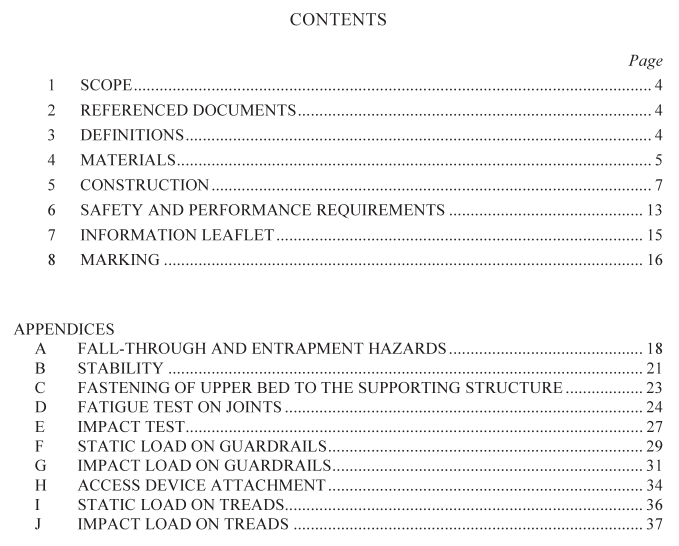AS NZS 4187 pdf download – Cleaning, disinfecting and sterilizing reusable medical and surgical instruments and equipment, and maintenance of associated environments in health care facilities

AS NZS 4187 pdf download – Cleaning, disinfecting and sterilizing reusable medical and surgical instruments and equipment, and maintenance of associated environments in health care facilities
1 sCOPE
This Standard specifies safety requirements for bunk beds and other elevated beds. Theseinclude material, construction, design, and performance requirements.
NOTE: Where this Standard uses term ‘bunk bed’it includes all beds within the scope of thisStandard.
2REFERENCED DOCUMENTS
The following documents are referred to in this Standard:AS
2281
Flexible cellular polyurethane for seat cushioning and bedding
4685
Playground equipment
4685
Part 1:General safety requirements and test methods
AS/NZS
4491
Timber——Glossary of terms in timber-related Standards
AS/NZS ISo
8124
Safety of toys
8124.1Part 1: Safety aspects related to mechanical and physical properties
(IsO 8124-1:2000, MOD)
8124.3Part 3: Migration of certain elements3 DEFINITIONS
For the purpose of this Standard, the definitions below apply.3.1 Access device
A rung-type ladder,step-type ladder,or other style of climbing aid provided for any bed inwhich the upper surface of the mattress base is more than 700 mm from the floor.
3.2Access opening
Opening in the guardrail that may or may not be accompanied by an access device.3.3 Bunk bed and elevated bed
3.3.1 Bunk bed
A set of components that is or can be assembled as beds,one stacked over the other (seeFigure 1); or
3.3.2 Elevated bed
Any elevated bed, other than a hospital bed, in which the upper surface of any mattress baseis 700 mm or higher above the floor surface.
3.4Climbing access opening
Opening in the guardrail that accommodates an access device.
A lateral component,fastened between a pair of structural uprights.3.6Gap
An opening bounded either by solid components of a bunk bed (see A in Figure 2) or bysolid components of the bunk bed and a straight imaginary boundary joining solidcomponents in such a manner as to result in a maximum bounded area (see B in Figure 2).3.7Grip
A component with a dimension that allows a child’s hand to securely grip the componentfor support (see Figures 3A and 3B).
3.8 Guardrail
A component of the bunk bed intended to prevent an occupant from falling off the bed.3.9 Sharp edge
An edge that fails the appropriate test specified in Clause 5.10.3.10 Sharp point
A point that fails the appropriate test specified in Clause 5.10.3.11 Mattress base
The surface on which the mattress is supported.3.12Side rail
A longitudinal component,fastened between a pair of structural uprights (e.g.corner posts)by which the mattress base may be supported.
3.13Structural uprights
Components to which other components such as the end and side rails are fastened to forma rigid structure. The structural uprights are intended to support the mass of the bunk bedand its contents (including the occupants).
NOTE: A common type of structural upright is the corner post as shown in Figure 1.3.14 Tread
A step or rung of a ladder or other structure designed for climbing.4MATERIALS
4.1Timber
Timber used in bunk beds shall not contain splinters, loose knots, compression failures, pithor reaction wood as defined in AS/NZS 4491 and shall be free from decay and insect attack,which would affect its safe handling or structural integrity and free from the addition ofpreservatives chemicals such as copper chrome arsenate (CCA).
NOTE: lt is recommended that the moisture content not exceed 13%.High moisture content cancause adhesive failure and excessive shrinkage, which would affect the structural integrity of thebunk.
4.2 Metals
All exposed metal components,including springs,nuts, bolts, and washers,shall be eithermade of corrosion-resistant material or be protected against corrosion.









